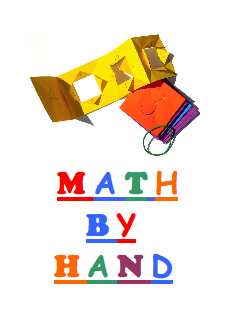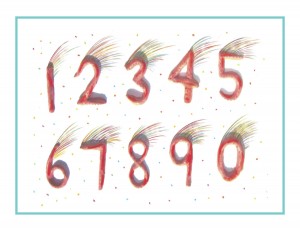
Day 9
For one year, 365 days, this blog will address the Common Core Standards from the perspective of creating an alternate, ambient learning environment for math. Ambient is defined as “existing or present on all sides, an all-encompassing atmosphere.” And ambient music is defined as: “Quiet and relaxing with melodies that repeat many times.”
Why ambient? A math teaching style that’s whole and all encompassing, with themes that repeat many times through the years, is most likely to be effective and successful. Today’s blog will focus on Standard 3 in the Kindergarten Operations and Algebraic Thinking. Note that the Common Core Standards will appear in blue, followed by an ambient translation.
Operations and Algebraic Thinking K.OA
3. Decompose numbers less than or equal to 10 into pairs in more than one way, e.g., by using objects or drawings, and record each decomposition by a drawing or equation (e.g., 2 + 3 = 5 and 4 + 1 = 5).
Today’s venue is big and colorful, and can be set up in or out of doors. Three large (at least 36″) circles will be used, with the left and middle circles containing the decomposed numbers and the circle on the right containing the number. The circles can be formed in several ways: 1) traced on the ground, pavement, or low-pile carpet using a stick or chalk, 2) homemade hula hoop circles, or 3) rope circles.
These circles can be used for large-motor movement that’s applied to almost any basic skill up to third grade, like number and letter formation, 4 processes practice, form drawing from first grade on, and just plain fun and games! Here’s how to make them.
1) Traced Circles: Cut a piece of string to about 1/2 the diameter of the circle plus an inch or so (20″ for a 36″ circle). Tie one end to a pointed stick or pencil and place it where you want your circle’s center to be. Tie the other end to whatever you’re using and walk around with the chalk/stick on the floor/ground, tracing your perfectly round circle!
2) Hula Hoops: Buy a roll of 3/4″ flexible vinyl tubing (white, clear, or colored) and as many connectors as you need (one for each hoop) at any hardware store. Measure the correct length (the top of the circle should come up to the user’s waist), and cut the tubing with a clipper, mat knife, or saw. Place the two ends in boiling hot water for 20 seconds, then slide the connector into both ends until they meet. For more fun, insert pebbles or beans to make a “rainstick” sound. The hoops can also be twirled around the waist, jumped over, or rolled on a smooth surface with a stick.
3) Rope: Tie a knot in soft, thick, colorful rope and test the circle for size. Trim the ends of the knot. Or for a more permanent circle, overlap the two ends at least 3″ and tape it with the same or a contrasting color.
Now for the math. Place the three circles on the ground or floor and represent the numbers in any of the following ways:
1) Stand in the right hand circle and jump or clap 5 times while counting, then hold up 5 fingers. Have the child(ren) stand in the far left circle and jump or clap a lesser number while counting, then hold up that number of fingers. Have the same child (or another) jump or clap the remaining number in the middle circle. Fully demonstrate this first, of course.
2) Make some (about 20) “flags” with sticks or dowels: cut colorful pieces of 9 x 12 felt in half diagonally and staple, glue, or sew them to the tops of the sticks/dowels. Note that any hands-on materials like these can be used repeatedly, and half the fun is making them, so have the child(ren) help as much as they can! Follow the same process with the flags, counting as you stick them into the ground. (This would need to be done outdoors on grass.)
3) Use any other (preferably large-ish) objects to do the same activity. Make it fun, and stop to play some games in between, like tag, hide and seek, or duck-duck-goose.
For the drawing on paper part, trace sets of three circles onto a large piece of cardboard or foam core (these will be used again and again) with markers or crayons. I like to use glasses or small plates as tracing templates. Have a pile of pennies or other small, flat objects like buttons on hand. Do the same as above, placing a number of objects in the right-hand circle and having the child(ren) fill the other two with the correct amounts. Place a piece of plain paper over all three circles, lightly taping down the corners, and have the children make “rubbings” with crayons, circling the groups of numbers when done.
BTW, you can find pieces of foam core and mat board at craft or frame stores for free or very little cost. You may want to save these finished drawings in a folder and bind them into a little book at the end of the year. Remember, knowledge ensues in an environment dedicated to imaginative, creative knowing, where student and teacher alike surrender to the ensuing of that knowledge as a worthy goal. More Kindergarten tomorrow!
Tags:
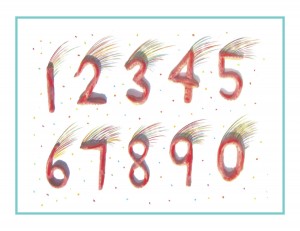
Day 8
For one year, 365 days, this blog will address the Common Core Standards from the perspective of creating an alternate, ambient learning environment for math. Ambient is defined as “existing or present on all sides, an all-encompassing atmosphere.” And ambient music is defined as: “Quiet and relaxing with melodies that repeat many times.”
Why ambient? A math teaching style that’s whole and all encompassing, with themes that repeat many times through the years, is most likely to be effective and successful. Today’s blog will focus on the Kindergarten Standard 2, in in Operations and Algebraic Thinking. Note that the Common Core Standards will appear in blue, followed by an ambient translation.
Operations and Algebraic Thinking K.OA
2. Solve addition and subtraction word problems, and add and subtract within 10, e.g., by using objects or drawings to represent the problem.
First a disclaimer on word problems. Perhaps sitting down and reading the problem on paper, then writing the answer is too advanced and abstract for now. It may be better to keep it real, large, and colorful. The “word problem” aspect could simply be a spoken one that’s kept simple and basic and includes lots of guidance throughout, all the way to the answer.
This standard and #’s 3, 4, and 5 are very similar. But rather than addressing them all together, I would like to use their similarity to separately explore different ways of approaching activities with addition and subtraction that are hands-on, movement oriented, creative, playful, and very lively.
Today I’m suggesting that the activity be taken outside: outdoors and outside the box. The exclusion of nature from our everyday lives is endemic, and it seems the children suffer most from this lack of exposure to nature. In fact, it is. now recognized as NDD, nature-deficit disorder. Here are a few excerpts about it from McMillan Buzz Word:
” . . . the premise of nature-deficit disorder goes beyond a simple lack of exposure to the countryside. The suggestion is that this is more like an illness, with symptoms which might include depression, hyperactivity, boredom, and loneliness . . . research suggests that a child’s ‘radius of activity’ . . . has declined by 90% since the 1970’s.”
“The expression nature deficit disorder was coined in 2005 by Richard Louv. The term originates from his bestselling book on the same topic entitled Last Child in the Woods – Saving Our Children from Nature-Deficit Disorder(Algonquin Books, 2005).”
In light of this, it may be highly beneficial to take some of your school activities out of doors. Barring this, due to extreme weather or other obstacles, by all means bring the great outdoors in! Here are some ideas:
Tall, ancient cedars grace our front yard where we live. They prolifically drop bark, seeds, and branches, so there are sticks everywhere! Go out with your child(ren) to the nearest woods, or just your own backyard, and gather a good amount of straight sticks. Learning large seems to be most effective, so look for sticks that are 18″ – 24″ long.
When you’ve gathered at least 20, set them aside in a pile on an open, flat area of grass or ground. If you’re working indoors, a bare floor space works. Borrow some of the verses from Over In the Meadow (Day 3 of this blog) to create some word problems like, “Crow needed more sticks to keep building her nest. She found 4 yesterday and 2 today, how many sticks did she find altogether?”
Or, “The old mother frog had trouble keeping track of her little froggies 7! They loved to jump everywhere in the meadow grass, and sometimes when the grass grew very tall, they were lost from her sight. Let’s pretend these sticks are the froggies and count 7 of them. Now let’s see, today 2 of them are hiding in the tall grass, so how many are left?”
You can use many other natural objects besides sticks for this, and have lots of fun with creating the word problems. Have the child(ren) act them out as well, jumping in the grass, and so on. It’s helpful to take the word problems from a familiar context, like a story you’ve told, a song you’ve sung, etc. Or make them up on the spot, drawing from the natural world all around you.
For the drawing portion of the standard, take one of the sticks and represent the numbers by drawing them on the ground or in the sand. If indoors, use large paper with crayons for counting on paper. You can use the lines mentioned yesterday: l, l l, l l l, l l l l, and l l l l with a diagonal line through it for 5 (two of them for 10). Or the dots that were used for the counting stones (with a different color, larger dot for 10). No numerals yet! They will come soon enough, next year . . .
Knowledge ensues in an environment dedicated to imaginative, creative knowing, where student and teacher alike surrender to the ensuing of that knowledge as a worthy goal. More Kindergarten tomorrow!
Tags:
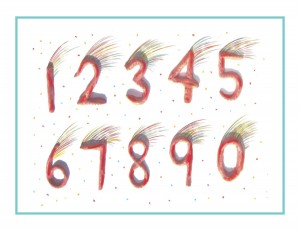
Day 7
For one year, 365 days, this blog will address the Common Core Standards from the perspective of creating an alternate, ambient learning environment for math. Ambient is defined as “existing or present on all sides, an all-encompassing atmosphere.” And ambient music is defined as: “Quiet and relaxing with melodies that repeat many times.”
Why ambient? A math teaching style that’s whole and all encompassing, with themes that repeat many times through the years, is most likely to be effective and successful. Today’s blog will focus on the Kindergarten Standard 1 in Operations and Algebraic Thinking. Note that the Common Core Standards will appear in blue, followed by an ambient translation.
Operations and Algebraic Thinking K.OA
Understand addition as putting together and adding to, and understand subtraction as taking apart and taking from.
1. Represent addition and subtraction with objects, fingers, mental images, drawings, sounds (e.g., claps), acting out situations, verbal explanations, expressions, or equations.
Algebraic thinking? Scary thought for Kindergarten. Here’s a little background information. The word algebra is taken from the Arabic “Al Jabr” which means “bone setting.” The Arabic mathematician, Al Khwarizmi (whose name provided us with the math words “algorithm” and “arithmetic”) wrote a book about algebra in the year 830 CE titled, The Science of Restoring What is Missing and Equating Like with Like.
Now as ambitious as the Common Core Standards are, they do not advocate including the algebraic “x” in Kindergarten! But we can view algebraic thinking as simply, equations. The numbers on both sides of the equals sign are, well, equal. Adding, subtracting, and in fact multiplying and dividing could be viewed as operating on numbers to make them equal, to “set their bones” so to speak, to make them whole again.
That said, how do we apply an ambient translation to Standard 1? Actually, this standard is quite ambient in itself. Yesterday’s activity with the counting stones and shells, acorns, etc. could be expanded upon to fit this quite nicely. It would probably be best to keep the adding and subtracting under 10 at first. Here are a few possibilities:
Put the counting stones and objects together to practice addition. For example, put the “3” counting stone to the left of 2 acorns, then count the total out loud using your pointer finger, 1-2-3 4-5, then place the “5” counting stone to the right of the acorns.
To practice subtraction, take a counting stone and cover some of the dots, then place the appropriate stone to the right of it. For example, cover 2 of the 5 dots and say, “5 take away 2,” then point to and count the remaining 3 dots saying, “1-2-3.” Place the “3” counting stone next to the “5” while keeping the 2 dots covered.
As stated in the standard, do use various means of representing the counting. For example, clapping the numbers described above (3 claps -space- 2 claps) could be call and response, with the child(ren) clapping the 5 in response. Try having them jump up and down, or march, or play a small drum or tambourine instead of clapping to represent the counting.
These activities should be as experiential and child-motivated as possible, similar to a Montessori approach. Remember that the optimal mood at this age is playful and joyful, so watch for signs of undue stress and switch to pure play at those times.
Remember that knowledge ensues in an environment dedicated to imaginative, creative knowing, where student and teacher alike surrender to the ensuing of that knowledge as a worthy goal. More Kindergarten tomorrow!
Tags:
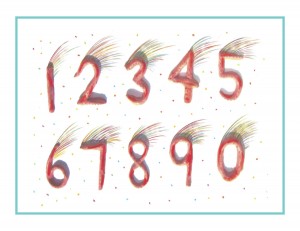
Day 6
For one year, 365 days, this blog will address the Common Core Standards from the perspective of creating an alternate, ambient learning environment for math. Ambient is defined as “existing or present on all sides, an all-encompassing atmosphere.” And ambient music is defined as: “Quiet and relaxing with melodies that repeat many times.”
Why ambient? A math teaching style that’s whole and all encompassing, with themes that repeat many times through the years, is most likely to be effective and successful. Today’s blog will focus on Counting and Cardinality / Compare Numbers / Standards 6 and 7. Note that the Common Core Standards will appear in blue, followed by an ambient translation.
Counting and Cardinality K.CC
Compare Numbers
6. Identify whether the number of objects in one group is greater than, less than, or equal to the number of objects in another group, e.g., by using matching and counting standards.
7. Compare two numbers between 1 and 10 presented as written numbers.
There’s that word, “written” again. At the risk of being stuck on a concept, I need to state again that numbers and letters are abstractions. Of course, numbers and letters will be absorbed by osmosis just by your child(ren)’s being in a very print-fiendly environment. And that’s fine, but osmosis vs. drill and test are two very different strategies. And waiting for readiness to teach and learn is so very essential. So, I’m sticking to my Waldorf principles here, and offering a substitute for written numbers.
In the first grade Math By Hand system, Roman numerals are taught first, because they are so close to primitive counting with fingers. Then the Arabic numerals are formally taught, along with the story of how their forms evolved, so they become less foreign and abstract. Diving into teaching the concept that the numeral 2 is the same as ( . . ) is a stretch for a Kindergartner.
Ok then, let’s see what can be done with Standard 6. Your Kindergarten room could be stocked with many natural objects, primarily used for playing and exploring, but also as learning materials. Just to name a few: acorns, shells, small stones, sanded and smoothed branches cut into slices or chunks, and many more. Left to their own devices out in nature, every young child is a collector! These natural beauties could all be kept in baskets.
For the “equal” portion, begin by using yesterday’s number stones, taking one of them (the number 5 for instance) and casually setting it in plain view on a desk or tabletop next to 5 of the objects. No need to instruct here, since imitation is such a prevalent quality at this age. You will see that the other counting stones will be eagerly matched up with their object counterparts. All you need do is provide the venue.
For the “greater and less than” portion, introduce the formal signs for this concept: < and >, in an imaginative and pictorial way. Again, this needs little to no words. Place two of the counting stones next to each other, or use a counting stone and objects as a pair. Using your index and middle finger to form the greater-less than signs, point the open end toward the larger number and pointing to the greater stone or objects say, “bigger.” Then pointing to the lesser stone or objects say, “smaller.” Once the concept is established the terms could be changed to “greater” and “less than” but no hurry on that.
Now for Standard 7. Again using the objects and stones, have the child(ren) write a simpler version of the numbers using lines for numbers 1-4, and 4 lines with a diagonal hash line for the number 5, and two of these for the number 10. Even though the written numerals have not even been touched yet, this kind of play learning builds an incomparable foundation for the more abstract concepts to be learned later, from first grade on.
And no, your Kindergartner will not be standardized test-ready but if you’re homeschooling that’s ok. And if you’re dealing with a “test-ready” classroom, you can still supplement school lessons with these fundamental and downright nourishing activities at home, to counteract the stress that may be occurring from too-early academics.
Knowledge ensues in an environment dedicated to imaginative, creative knowing, where student and teacher alike surrender to the ensuing of that knowledge as a worthy goal. More Kindergarten tomorrow!
Tags:
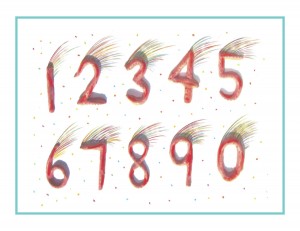
Day 5
For one year, 365 days, this blog will address the Common Core Standards from the perspective of creating an alternate, ambient learning environment for math. Ambient is defined as “existing or present on all sides, an all-encompassing atmosphere.” And ambient music is defined as: “Quiet and relaxing with melodies that repeat many times.”
Why ambient? A math teaching style that’s whole and all encompassing, with themes that repeat many times through the years, is most likely to be effective and successful. Today’s blog will focus on the Kindergarten standard 5 in Counting and Cardinality. Note that the Common Core Standards will appear in blue, followed by an ambient translation.
Counting and Cardinality K.CC
Count to tell the number of objects.
5. Count to answer “how many?” questions about as many as 20 things arranged in a line, a rectangular array, or a circle, or as many as 10 things in a scattered configuration; given a number from 1-20, count out that many objects.
I’m imagining a workbook or worksheet, with the objects displayed in a similar manner as described above. And the question arises: Do worksheets belong in Kindergarten? If we come from a perspective of more healthy play and movement than academic abstraction, the answer is decidedly no.
Now regarding the question of waking up the intellect too early, it gets even trickier. Let’s see how playful and moving this can be! Access the concept of number and value by using visual counters that represent the numbers (echoing yesterdays number jar activity), thus conveying the essence of each number tactilely and visually, without being too abstract.

Create counting stones like those pictured above and store them in baskets, available for play anytime. For this activity use blank stones to create the arrays described in Standard 5, then have the counting stones visible when you ask how many in an array, so the correct stone can be pointed to as the number is said.
For more gross motor movement, draw 10 circles on the ground or cut out 10 construction paper circles and place them on the floor in the arrays described in Standard 5, and have the child(ren) jump from one to the other as they count. Again, have the counting stones handy for reference. Or use yesterday’s number jars to count up to 20.
Have the child(ren) say/sing the counting verse: One, Two, Buckle My Shoe while jumping the circles up to 10 or 20.
1-2 buckle my shoe,
3-4 knock at the door,
5-6 pick up sticks,
7-8 lay them straight,
9-10, a big fat hen,
11-12, dig and delve,
13-14, who’s a’ courting,
15-16, who’s in the kitchen,
17-18, who’s a waiting,
19-20, my platter’s empty
Always keep it lively, and remember that knowledge ensues in an environment dedicated to imaginative, creative knowing, where student and teacher alike surrender to the ensuing of that knowledge as a worthy goal. More Kindergarten tomorrow!
Tags:
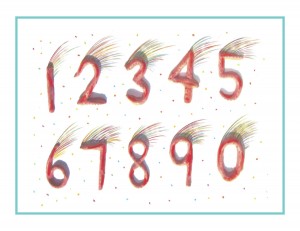
Day 4
For one year, 365 days, this blog will address the Common Core Standards from the perspective of creating an alternate, ambient learning environment for math. Ambient is defined as “existing or present on all sides, an all-encompassing atmosphere.” And ambient music is defined as: “Quiet and relaxing with melodies that repeat many times.”
Why ambient? A math teaching style that’s whole and all encompassing, with themes that repeat many times through the years, is most likely to be effective and successful. Today’s blog will focus on a, b, and c of the fourth Kindergarten standard in Counting and Cardinality. Note that the Common Core Standards will appear in blue, followed by an ambient translation.
Count to tell the number of objects.
4. Understand the relationship between numbers and quantities; connect counting to cardinality.
a) When counting objects, say the number names in the standard order, pairing each object with one and only one number name and each number name with one and only one object.
b) Understand that the last number name said tells the number of objects counted. The number of objects is the same regardless of their arrangement or the order in which they were counted.
c) Understand that each successive number name refers to a quantity that is one larger.
I must say that I’m having a bit of a brain freeze here. This is so intricately worded that it’s challenging for me to unravel and translate into kindergartenese. I would venture to guess that there is some of the same challenge as teachers and students alike attempt to hone each standard into a practical, workable format.
Ok, let’s see. Cardinality in number tells quantity or how many. Simple enough, but sorting that concept out from assigning each of the counting numbers its own name and identity is tricky. Disclaimer: as said earlier, until first grade a less intellectual or abstract approach is best. So better to keep it as concrete as possible.
The Math By Hand system uses beans for value coding ones, tens, and hundreds to teach place value in second grade. Black beans are ones, kidney beans are tens, and lima beans are hundreds. Without becoming too abstract, it may be possible to teach these standards’ concepts using the beans. Here’s the thought:
You’ll need black beans, kidney beans, and 20 small glass jars or clear plastic containers. For the first 10 jars, place 1 black bean in jar one, 2 in jar two, and so on up to 9 in jar nine. Place 1 kidney bean in jar ten, 1 kidney and 1 black bean in jar eleven, and so on up to jar nineteen. Place 2 kidney beans in jar twenty.
No need to label the jars with their numbers, since the number of beans inside says which each jar is. This builds a wonderful foundation for understanding place value as well, without getting too abstract. The jars themselves represent the number of objects, and the beans inside tell which is which. Now, you can line the jars up in order to see that each successive number name refers to a quantity that is larger, and if you mix jars one to five (for example) out of counting order, it’s plain that they can still be counted as 5 jars.
There’s a bit more of a Montessori than a Waldorf feel to this activity, but I like that sort of eclectic approach. That may be why, even though I taught in a Waldorf classroom, at heart I favor a more inclusive, blended method. And I do believe Waldorf homeschooling is an excellent venue for doing just that!
Always remember that knowledge ensues in an environment dedicated to imaginative, creative knowing, where student and teacher alike surrender to the ensuing of that knowledge as a worthy goal. More Kindergarten tomorrow!
Tags:
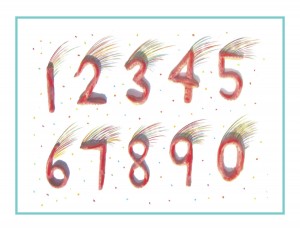
Day 3
For one year, 365 days, this blog will address the Common Core Standards from the perspective of creating an alternate, ambient learning environment for math. Ambient is defined as “existing or present on all sides, an all-encompassing atmosphere.” And ambient music is defined as: “Quiet and relaxing with melodies that repeat many times.”
Why ambient? A math teaching style that’s whole and all encompassing, with themes that repeat many times through the years, is most likely to be effective and successful. Today’s blog will focus on the first three Kindergarten standards in counting and cardinality. Note that the Common Core Standards will appear in blue, followed by an ambient translation.
Counting and Cardinality K.CC
Know number names and the count sequence.
1. Count to 100 by ones and tens.
2. Count forward from a given number within the known sequence (instead of having to begin at one).
3. Write numbers from 0 to 20. Represent a number of objects with a written numeral 0-20 (with 0 representing a count of no objects).
Counting could happen in the Kindergarten in a playful way, with movement and verses or songs. After the song(s) are learned, objects could be gathered to represent each number, or a finger count could show each number as it’s sung. As stated yesterday, writing the numbers with pencil and paper would be too abstract and intellectual for this age. Remember that imaginative play is paramount now, with academics best saved for first grade.
Here’s a wonderful little song that my daughter Cassie and I loved and sang together many, many times, from age 3 on through first grade. There’s a verse for each number, and I will share the entire first verse then just the changeable parts for all the other numbers. (You can find the tune online if you don’t already know it.) I will also include suggestions for body or finger movements.
1)
Over in the meadow in the sand and the sun, (Hands and arms held rounded above head)
Lived an old mother turtle and her little turtle one. (1 finger held up)
“Dig,” said the mother, (Cupped hands digging motion at waist level for both lines)
“I dig,” said the one, and they
Dug all day in the sand and the sun. (Hands and arms held rounded above head)
2)
. . . where the stream runs blue, (Hands palms together waist level, making a swimming motion)
. . . fish and her little fishies two. (2 fingers held up)
. . . swim . . . we swim . . . swam all day where the stream runs blue. (Movement same as above)
3)
. . . in a hole in a tree, (Thumb and forefinger make a circle, raised to one eye)
. . . owl and her little owlets three (3 fingers held up)
. . . whoo . . . we whoo . . . whooed all day in their hole in the tree. (Movement same as above)
4)
. . . by the old barn door, (Hands and arms extended wide, shoulder level)
. . . rat and her little ratties four. (4 fingers held up)
. . . gnaw . . . we gnaw . . . gnawed all day on the old barn door. (Movement same as above)
5)
. . . in a snug beehive, (Thumbs and forefingers pinched together and circling while saying “bzzzzz”)
. . . bee and her little bees five. (5 fingers held up)
. . . buzz . . . we buzz . . . buzzed all day in their snug beehive. (Movement same as above)
6)
. . . in their nest built of sticks, (Hands cupped, wrists together, held in front of chin)
. . . crow and her little crows six. (6 fingers held up)
. . . caw . . . we caw . . . cawed all day in their nest built of sticks. (Movement same as above)
7)
. . . where the grass grows so even, (Hands held up together, thumbs and palms in, other fingers straight up)
. . . frog and her little froggies seven. (7 fingers held up)
. . . jump . . . we jump . . . jumped all day where the grass grows so even. (Movement same as above)
8)
. . . by the old mossy gate, (One arm swings out and in, shoulder level)
. . . lizard and her little lizards eight. (8 fingers held up)
. . . bask . . . we bask . . . basked all day by the old mossy gate. (Movement same as above)
9)
. . . by the old scotch pine, (Hands palms together, arms stretched high above head)
. . . duck and her little duckies nine. (9 fingers held up)
. . . quack . . . we quack . . . quacked all day by the old scotch pine. (Movement same as above)
10)
. . . in a cozy wee den, (Hands and arms crossed over heart)
. . . beaver and her little beavers ten. (10 fingers held up)
. . . beave . . . we beave . . . beaved all day on their cozy wee den. (Movement same as above)
For counting to 100 (backwards) you could sing a lively kindergarten-friendly version of the song: “99 Bottles of Milk on the Wall,” having the child(ren) repeat the lines by rote. You could adjust it for counting forward by singing, “1 bottle of milk on the wall, 1 bottle of milk, if another bottle should happen to join, 2 bottles of milk on the wall.”
You could then switch it to 10, 20, 30, etc. Remember this is all rote and repeat after you, not expecting any retention at this age. This song could be sung while lining up objects that represent the bottles of milk on the wall, up to 20. And you could start the counting sequence anywhere in the song and continue singing, again by rote only.
Choose other counting verses and songs, add movements, and keep it lively! Singing sometimes seems a lost art these days. Remember that knowledge ensues in an environment dedicated to imaginative, creative knowing, where student and teacher alike surrender to the ensuing of that knowledge as a worthy goal. We will continue with Kindergarten tomorrow!
Tags:
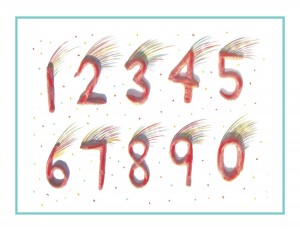
Day 2
For one year, 365 days, this blog will address the Common Core Standards from the perspective of creating an alternate, ambient learning environment for math. Ambient is defined as “existing or present on all sides, an all-encompassing atmosphere.” And ambient music is defined as: “Quiet and relaxing with melodies that repeat many times.”
Why ambient? A math teaching style that’s whole and all encompassing, with themes that repeat many times through the years, is most likely to be effective and successful. Today’s blog will focus on the introductory overview for Kindergarten. Note that the Common Core Standards will appear in blue, followed by an ambient translation.
In kindergarten, instructional time should focus on two critical areas: (1) representing, relating, and operating on whole numbers, initially with sets of objects; and (2) describing shapes and space. More learning time in kindergarten should be devoted to number than to other topics.
Back in the 50’s, the local Catholic school I attended began with first grade, so my kindergarten experience was similar to the Waldorf model. That is, a homey environment where I helped with chores by following in the footsteps of adults, and played in and out of doors for most of the day.
Unstructured time such as this, devoted to creative, imaginative play and imitation of adults is most essential for the kindergartner. Therefore, instructional time and the concept of formal learning may not be the most desirable approach. It may in fact be possible to reach all of the goals described below in a more gentle, integrated way.
(1) Students use numbers, including written numerals, to represent quantities and to solve quantitative problems, such as counting objects in a set; counting out a given number of objects; comparing sets or numerals; and modeling simple joining and separating situations with sets of objects, or eventually with equations. (Kindergarten students should see addition and subtraction equations, and student writing of equations is encouraged, but it is not required.)
Again, a formal learning environment is not optimal at this age. The above goals could be reached in the following ways. In a Waldorf Kindergarten or in a home environment (the two are often interchangeable) many opportunities arise for counting and acquiring a sense for the quantity of number.
Playing with blocks or helping cook soup for lunch are two such opportunities. A whole carrot becomes a dozen pieces, or two towers of blocks represent single numbers that can be added together in several ways, by themselves and with each other. Thus the concepts of addition, subtraction, multiplication and division (and even fractions!) are put in place foundationally, in a much deeper way than if the child is required to abstract them with pencil and paper.
(2) Students describe their physical world using geometric ideas (e.g., shape, orientation, spatial relations) and vocabulary. They identify, name, and describe basic two-dimensional shapes, such as squares, triangles, circles, rectangles, and hexagons, presented in a variety of ways (e.g., with different sizes and orientation), as well as three-dimensioanl shapes such as cubes, cones, cylinders, and spheres. They use basic shapes a spatial reasoning to model objects in their environment and to construct more complex shapes.
Shape and form is optimally experienced through the physical senses: movement, verbal description, tactile observation. Shape sorters such as those used by toddlers (fitting a square in a square hole, etc.) are tactile enough but may be a reductive version of a more whole-body experience.
In the Waldorf first grade, numbers are connected with geometric shapes: 1 to a circle, 3 to a triangle, 4 to a square, 6 to a hexagon, etc. These ideas are related through fairy tales, such as “The Queen Bee,” later tied in with the bees’ hexagonal honeycomb. The number stories could be told foundationally in Kindergarten then related to their individual numbers later on, instilling a deep sense for corresponding shapes with number.
The Kindergarten environment could be richly endowed with all such shapes, to be played with and experienced, but not yet abstracted into formal geometry. Last but not least, shape could be bodily experienced through movement: running in a circle, walking in a square, forming a triangle with arms and hands joined above heads, etc.
This is an introductory overview, and will be followed by translating each standard individually into a more ambient mode. I only hope my penchant for making the abstract real and tangible in many and diverse ways will hold up through all of these complicated and complex standards!
In closing, may I repeat that I believe the “back door” or indirect approach is a very effective teaching tool, especially with math. Most children will happily and eagerly take on any task presented in a friendly, warm, and meaningful way.
In light of this, true knowledge ensues in an environment dedicated to imaginative, creative knowing, where student and teacher alike surrender to the ensuing of that knowledge as a worthy goal. More Kindergarten tomorrow!
Tags:
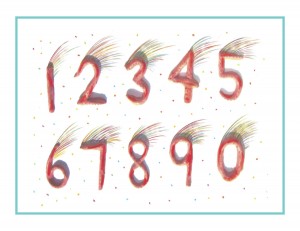
Day 1.
For one year, 365 days, this blog will address the Common Core Standards from the perspective of creating an alternate, ambient learning environment for teaching math. Each standard will be given an ambient translation, with suggestions for lessons and activities that match it. The goal will be to address the math standards from Kindergarten on to at least Grade 5 (maybe further). This said, Kindergarten will perhaps be the most challenging, since the need for a truly ambient math is greatest at that level.
Ambient is defined as “existing or present on all sides, an all-encompassing atmosphere.” And ambient music is defined as: “Quiet and relaxing with melodies that repeat many times.” (By the way, the soundtrack for the many hours spent at the computer creating Math By Hand has been taken exclusively from the iTunes Ambient channel.)
Why ambient math? If your math teaching style is ambient, presented in a whole, all-encompassing way, it will be more apt to be absorbed naturally, as languages are by very young children. The 7 – 14 year old child learns best when abstract concepts are cloaked in images, movement, and stories. Because math tends to be the subject most prone to abstraction, it’s most essential for the teacher to be conscious of keeping all lessons and activities real, colorful, and lively.
Math lessons should be quiet and relaxing, with themes that repeat many times. Factoring for instance, could be taught at first in a whimsical, pictorial way, then brought back again and again, progressively more abstractly. This is sometimes called the spiral method, as the same idea is revisited again and again, on higher levels.
I believe that the “back door” or indirect approach is a most effective teaching tool, especially with math. Most children will happily and eagerly take on any task presented in a friendly, warm, and meaningful way. When I taught math to third graders in a Waldorf classroom, they gleefully learned their times tables playing Baseball Math. The correct answer to a pitched problem was always a hit!
The Race to the Top, as espoused by the Common Core Standards, is a most direct approach. This approach does not translate well, whether in the classroom or homeschool environment. As Viktor E. Frankl says in Man’s Search for Meaning, “Don’t aim at success. The more you aim at it and make it a target, the more you are going to miss it. For success, like happiness, cannot be pursued; it must ensue, and it only does so as the unintended side effect of one’s personal dedication to a cause greater than oneself or as the by-product of one’s surrender to a person other than oneself . . .”
In light of this, knowledge ensues in an environment dedicated to imaginative, creative knowing, where student and teacher alike surrender to the ensuing of that knowledge as a worthy goal. So, on to Kindergarten tomorrow! Note that the age range stated above for imaginative learning was 7-14 years. Before 7, the child’s most important work is play, along with a playful, loving imitation of surrounding adults. So, blending the academic Common Core Standards with that sort of environment will indeed be a challenging task!
Note that most observations and correlations will be Waldorf-inspired since that is my teaching base. And because after many years of consideration and comparison, it still stands out as the most sensible, child-friendly way to teach and learn.
Tags:

Norman Davidson was a journalist, a Waldorf high school teacher, and the Director of the Waldorf Teacher Training at the Sunbridge Institute in Spring Valley, NY. He inspired so many to teach in a way that reached beyond the everyday to the deepest heart and soul. Above all, he taught that the teacher must convey a heartfelt, vital interest in the student(s) and in the subject at hand.
When asked where the Waldorf teacher might find sources for what is to be taught he replied, “Go to the library, find books on the subject, and enLIVEN it.” No need to plumb the depths of esoteric books or sources, but rather ground the teaching in everyday reality, then find the magic within that lies sleeping in all things. And teach that!
One of Rudolf Steiner’s best pieces of advice to teachers was something to the effect of “Good teaching is like being caught in the rain without an umbrella.” A willingness to be vulnerable, to go out on a limb, to show the children that you are striving right there along with them, are all the hallmarks of a good teacher. A wonderful, well-thought-out lesson plan is not always the be-all / end-all. Sometimes something else comes along that not only circumvents your lovely plan, but allows you and your child(ren) a glimpse into a greater reality, and an opportunity to learn the most valuable lesson, life itself.

This is just what happened to Norman Davidson one day in one of his high school classes. He tells the tale here:
A LESSON IN THE DARK
Description of a classroom experience in a Waldorf school
By Norman Davidson
I walked across the school playground towards the classroom thinking about Ernest Hemingway. It was a fresh, sunny day in late autumn, but inwardly I was transporting myself to the seas around Cuba where big fish are caught, and to the sun drenched arenas of Spain where the ritual of killing the bull is enacted. In both, the human being relates to nature in a strange and contradictory way—predatory yet awe filled in the presence of death; hunting for challenge, yet really hunting after oneself. Similar contradictions, translated into social relationships must surely lie, I thought, somewhere in the feeling life of many a young teenager, and wait to be solved.
Many things go through the mind of a teacher on his way to the classroom, especially if he is new to the school as I was. Had I prepared the lesson properly? Would it be received well? Would it relate to the young people before me? I was sure that Hemingway related sooner or later to the class of thirty or so boys and girls around the age of fifteen towards whom I now walked in this British Waldorf school. But nevertheless the night before I had wondered about presenting Hemingway just at that time in these literature and English lessons. I entered the school and walked down the corridor. It was too late now to change.
Expectancy
When I arrived outside the door it was shut. On opening it there was a double shock. Firstly, I stepped from a bright, sunny atmosphere into complete darkness. The window blinds were tightly down, and I could hardly see my way to the teacher’s desk. Secondly, although I could sense a lot of people in my presence, there was hardly any sound. I had to think quickly. This was not a particularly easy class in some ways. A few days before, a group of them had sat in the playground in a circle after the school bell, protesting against something. So now they were testing me. Instinctively I knew why they were doing it. “Who are you?” they were saying. “Throw away your book and your briefcase. What are you going to do now?”
I walked towards the window where light showed, but quick hands closed up the chink. The first impulse was to admonish them strongly for being so silly, switch on the light and demand that they immediately pull up the blinds. After all, my lesson was being infringed, and time was being wasted. But the hush in the class made me hesitate. I could hear them breathing and listening and occasionally whispering— all thirty of them. The air was full of expectancy. I stopped myself from reacting as a conventional ‘teacher’ and wondered what I could do as an unconventional one.
Reversed mime
I felt my way round to the front of the teacher’s desk and stood staring into darkness. Boy, could these children wreck a lesson! So I thought that the best thing would be to say the first meaningful thing that came to me and take it from there. I heard myself say, “For today’s lesson you are going to have to use somewhat more imagination than usual.” (There was a ripple of conceding laughter. Well, that was something.) “You will have to listen to my voice today without the help of seeing my movements, gestures and facial expressions. A kind of reversed mime. So you’ll have to listen more carefully. (Sounds of “Shh.”)
“When you don’t see someone’s face who is talking, you can more easily be led astray as to shades of meaning. I might, for instance, be saying all this to you in a serious voice, but without you knowing it could be grinning like an ape.” (I grimaced crazily into the darkness and, sensing it, the class rippled with laughter again, then fell silent, waiting.)
I was at sea, but it was less and less Hemingway’s Caribbean. The big fish and the bulls were receding into the dim distances in my mind. I was brought intensely to the here and now of thirty young people who needed something and were teaching me how to teach it. So I plunged into this new sea and into the uncanny experience of having to imagine the young people to whom I was talking, even though I knew them. Gradually, the lesson was drawn out of me. The following are paraphrases of parts of it.
Pure thoughts
“You’ll have to see today with your thoughts. For someone like the great philosopher Plato, to think was to see. Even in English we say ‘I see’ when we understand something with our thoughts. Some people can see with their thoughts very well. Being without sight is a help. During the last war there was a blind resistance fighter in the French underground movement to whom all recruits for the resistance were brought. He could tell by the tone of the person’s voice in answer to questions whether he was a spy or not. It is also known that blind people dream in pictures…
“Now take a subject which involves pure thoughts which you can see inwardly. This is geometry. Next year I shall be taking you for a Main Lesson in this subject. At the beginning of the century a famous geometrician called Klein deliberately gave a lecture with the lights switched off. He asked his audience to imagine the geometry he was talking about in clear thought, without distraction, showing that mathematics lives in the realm of pure thought. So, imagine now what I shall be asking you next year. Picture two points in space. Now through these you can draw one straight line. But what about three points? Three lines. And what else goes through any three points in space? One plane. And what about any four points in space? How many lines and planes can pass through them…?
“In two years’ time we shall be together again for a Main Lesson in the history of language. We shall first study speech. Speech reveals the whole human being. A whole human being is expressed in its sickness or health, balance or unbalance, in the expression of the voice…
Darkness. What is it? Is it merely an absence of light? Or has it another content? We look for the dark when we want to do something we are ashamed of. (Giggles) What, then, is shame? Why is one ashamed? Should we do things we are ashamed of…? “We also seek darkness to meditate. We shut out the outside world and step into an inner one. Homer was a blind poet…
“Why does darkness sometimes bring fear if we are alone? What are we really frightened of…? “Yet in darkness a certain intimacy can grow which is not so easy in broad daylight. I feel your presence stronger, I think, than if I could see you. One can feel more awake in the dark, more sensitive. There is a grand old lady teacher at my previous school who is now blind. The little children run to take her hands and guide her when she appears. Her hands are beautifully soft and one knows that she can see with them when she touches things. And her mind is as clear as a bell…
“In Class 12 we are studying astronomy at the moment and today we discussed eclipses. An eclipse is an absence of the sun’s light when normally it should be there. It is an intervention in life. It brings effects which would not normally arise. For instance, the sun’s corona (or surrounding halo of light) becomes visible which is normally invisible. The activity around the periphery of the sun can be seen against the darkened sky during a sun eclipse. This lesson does the same! I am not teaching what I prepared, but a completely new subject has become visible to us today. It is the question of light, darkness and inner life of the human being. This will lead us on to further work in other lessons. “At least I think it will lead to further work with you. I am assuming that you are my English class, although I can’t see that you are! In any case, its been interesting talking to you. Thank you for the opportunity to discuss something unusual. Whoever you are good morning.”
Inner Polarities
I made my way to the door, went out and closed it behind me. Next day not a word was said by myself or the class about the lesson. There was a warmth in the air, but nothing was said. Something was living inwardly. It was like a secret between us. It would have seemed empty and superficial to have talked ‘about’ it. The incident opened up for me in a special way what I had often thought about concerning the puberty age group and had discussed with my colleagues: the question of inner polarities experienced at this time, of subjective and objective, freedom and authority, inner and outer, light and darkness, etc. Something was drawing inward in the young person, and the darkness had given it space to work. And behind it was an imaginative, inventive call from young people for new life from their environment, a justifiable call on entering the realm of secondary education. The dry book of instruction had been left unopened, the briefcase left on the floor, and even the sight of the teacher had been dispensed with. So, in the clear daylight of the lesson which followed the next day, I worked, much to their interest, on the life of Helen Keller who was deaf and blind from a young age.
The original of this article appeared in “Child and Man: A Journal for Contemporary Education” (Steiner Schools Fellowship, England, Summer-Autumn 1978).

Tags:

